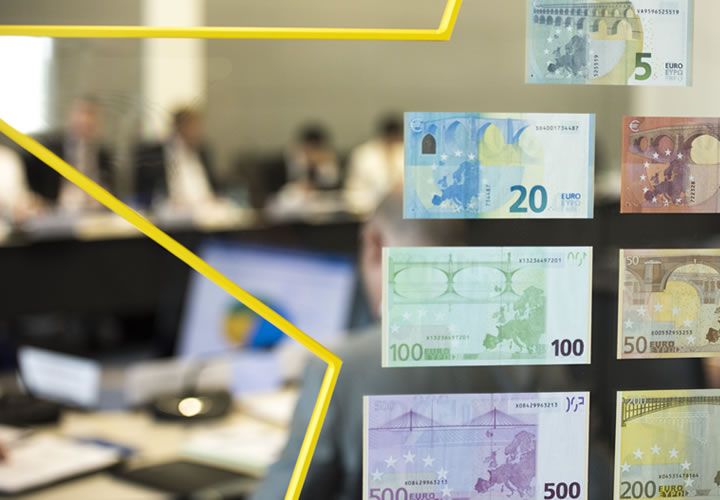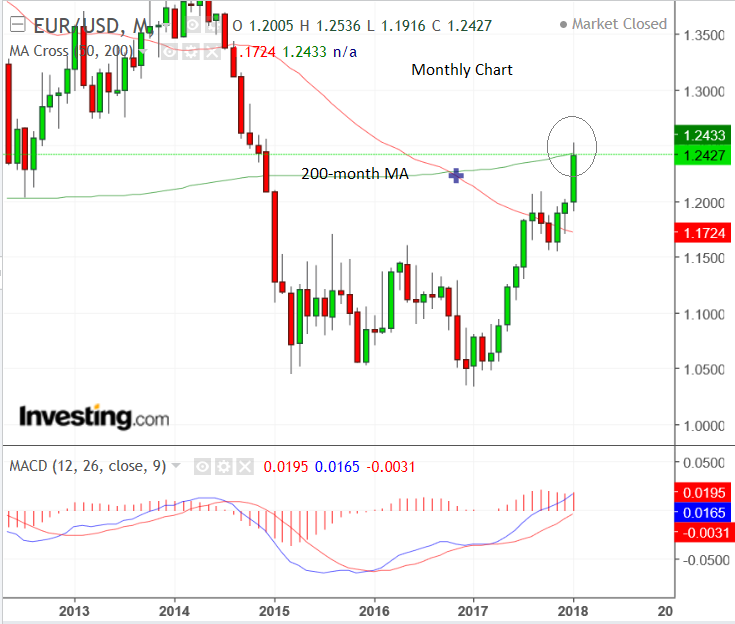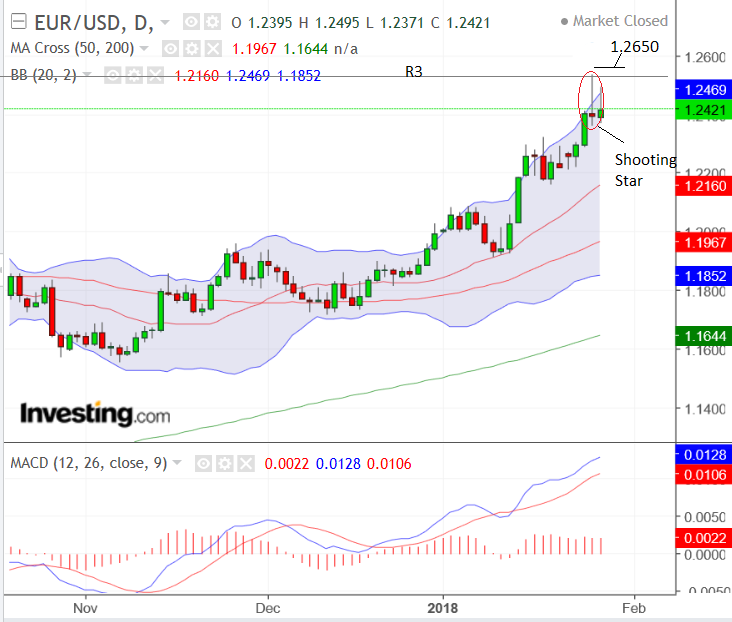Euro-to-Dollar Rate Forecast for the Week Ahead

The EUR/USD exchange rate may be peaking after it has reached a significant chart level in the form of the 200-month MA and there is a higher probability now of a more substantial pull-back.
The Euro has been in a strong uptrend against the US Dollar since the start of 2017 but could now have reached a significant level in the form of the 200-month moving average (MA) at 1.2427, which could represent an obstacle to further gains.
This may well be a ceiling for the pair since a break through the 200 MA is likely to be incredibly diffcult and the pair will probably stall, pull-back or maybe even reverse trend at the current level.
The reason for this is that such technical levels are typically layered with orders as traders anticipate a change of trend in the run-up to this level. In this case we would anticipate an increase in the supply of Euros.

Note the reaction from the exchange rate in the chart above which occurred when it met the 50-month MA (red line) in 2017 - a similar reaction is possible at the level of the 200-month.
The daily chart is also showing warning signs which indicate the uptrend may be faltering in the short-term.
The pair has formed a bearish shooting star Japanese candlestick pattern on the daily chart on Thursday's highs.
In addition, the pattern occurred at the very top of the bollinger band, a price jacket drawn at two standard deviations from the 20-day moving average of the pair, which represents an extended extreme (shaded area beow) - when a bearish candlestick forms with more than half the range sticking above the bollinger band it is normally a sign the exchange rate will correct back.
A further hindrance to an extension higher is the R3 monthly pivot at the 1.2530.
Monthly Pivots are barriers to further upside as they attract a lot of selling interest from short-term technical traders looking to counter-trend the rally.

Get up to 5% more foreign exchange by using a specialist provider to get closer to the real market rate and avoid the gaping spreads charged by your bank when providing currency. Learn more here.
Data and Events for the Dollar
It is an extremely busy week for the Dollar with no less than two exceptionally market moving data releases: the Federal Reserve's open market committee meeting (FOMC) on Wednesday evening at 19.00 GMT and then Non-Farm Payrolls (NFP) on Friday at 13.30.
The FOMC is important because it votes to decide the level of base interest rates in the US which has a direct impact on the Dollar via inflows, because higher rates attract greater inflows drawn by higher returns, which increases demand for the Dollar.
NFP's are important as a barometer of the health of the US economy and a gauge of inflation pressures. A higher NFP result tends to lead to expectations of higher inflation, which leads to expectations that the Fed will raise interest rates, which drives up the Dollar.
Probably of more import is the accompanying data on wages, since it is really wage inflation which tends to push up general inflation by giving workers more disposable cash.
Indeed, the Fed's prefered gauge for inflation: Personal Consumption Expenditure (PCE), is out on Monday, January 29, at 13.30 and is forecast to show a 0.2% rise in December compared to November, and a 1.5% rise compared to the same time a year ago.
Given the importance of inflation expectations in deciding interest rates PCE could impact on the FOMC meeting if it surprises in either direction.
Data and Events for the Euro
Eurozone inflation is probably the most important release for the Euro in the week ahead. The market currently expects it to moderate to 1.3% year-on-year (yoy) from 1.4% yoy in December so a drop may not impact on the Euro as much as might be expected.
The outcome is important in the context of how the European Central Bank (ECB) approaches its policy settings going forward - if inflation is seen accelerating then there is a chance that they will soon indicate they are to end their extraordinary monetary stimulus programme.
Markets are currently betting that this is indeed likely to occur in coming months, hence we saw the Euro rally following the outcome of the ECB's January policy meeting update.
Stronger inflation will reaffirm this trend.
Analysts at TD Securities however warn the market is being too optimistic and inflation will probably show a fall to 1.1% because of the drag owing to, "base effects after large gains in food and energy prices in Jan 2017."
This could certainly weigh on the Euro.
Like the market, however, they see Core Inflation - which does not include food and fuel - rising to 1.0% but also languishing at that rather low level for the remainder of the first half of the year.
The release for both is out at 10.00 GMT on Wednesday, January 31.
Tuesday, January 30 sees the release of Q4 GDP for the Eurozone - also at 10.00 - which is expected to show a rise of 2.6% yoy and 0.6% quarter-on-quarter - the same as in Q3 - a stronger-than-expected print would probably give the Euro another boost and vice versa for a weaker.
"Preliminary estimates of euro area fourth-quarter GDP figures are eagerly awaited by analysts and are widely expected to be strong given the recent flow of positive data. IHS Markit PMI data signaled an impressive 0.8% expansion in the final three months of 2017, higher than the 0.6% in the third quarte," says IHS Markit in a briefing on the events to watch in the coming week.
Unemployment data, out at the same time is forecast to remain at 8.7% in December. Both GDP and employment data are unlikely to impact the single-currency to the extent that inflation would.
However, another big release to watch is the Eurozone Manufacturing PMI, out at 9.00 on Thursday, Feb 1, which is forecast to stay unchanged at 59.6 in January.
The data should confirm that the Eurozone economy is expanding at a blistering pace, as per the prelimary estimate released last week, and is therefore providing a fundamental unerpinning to the Euro's long-term rise.
However, the surprise-factor of a final estimate is never as great as the preliminary release, so expect a muted Euro reaction.
Get up to 5% more foreign exchange by using a specialist provider to get closer to the real market rate and avoid the gaping spreads charged by your bank when providing currency. Learn more here.




